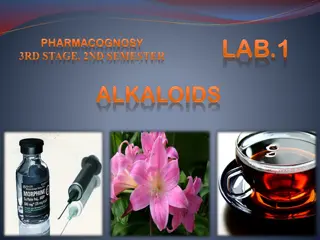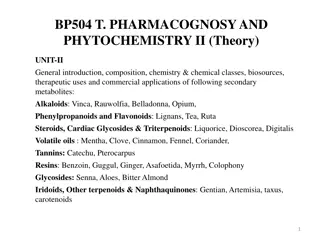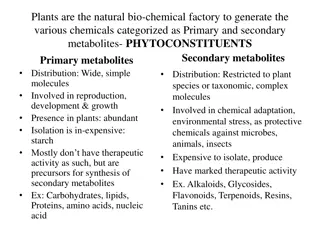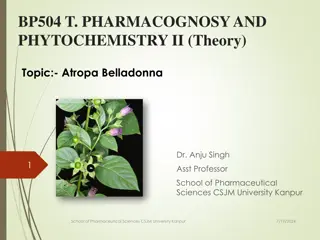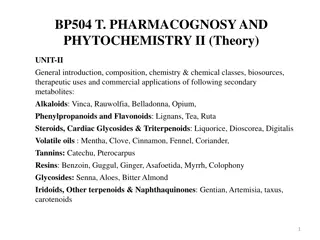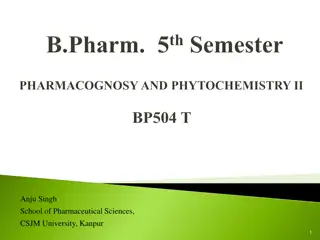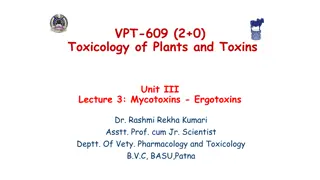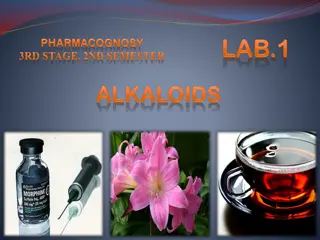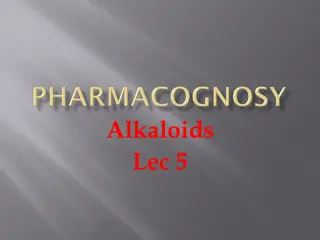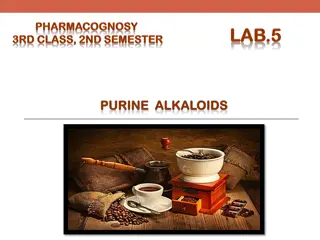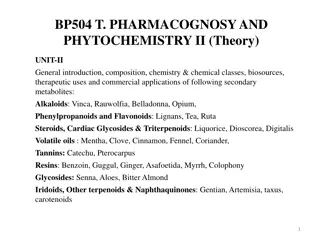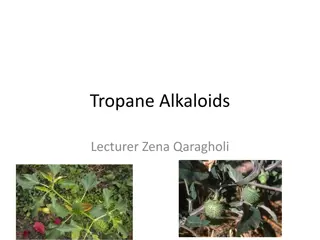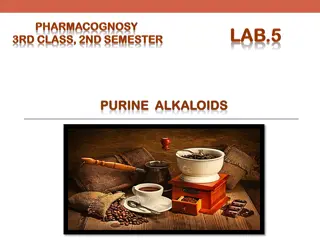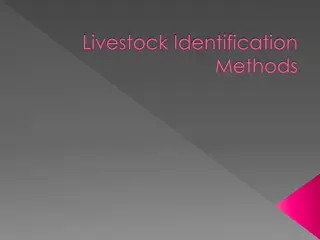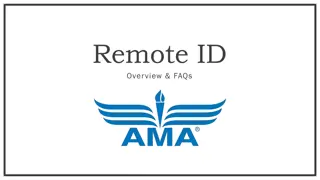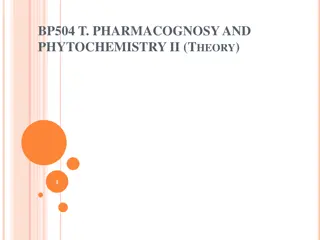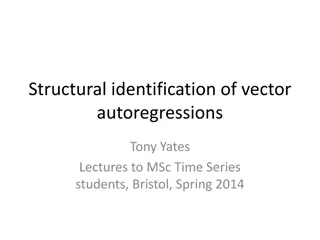Belladonna Alkaloids Identification Methods and Analysis
Learn about the qualitative and quantitative analysis methods for identifying belladonna alkaloids. Discover the differences between titration and back-titration, and follow a detailed procedure to quantitatively identify the alkaloids present. Equip yourself with the required equipment and reagents for the analysis, and understand the specific tests involved in the process.
Download Presentation

Please find below an Image/Link to download the presentation.
The content on the website is provided AS IS for your information and personal use only. It may not be sold, licensed, or shared on other websites without obtaining consent from the author.If you encounter any issues during the download, it is possible that the publisher has removed the file from their server.
You are allowed to download the files provided on this website for personal or commercial use, subject to the condition that they are used lawfully. All files are the property of their respective owners.
The content on the website is provided AS IS for your information and personal use only. It may not be sold, licensed, or shared on other websites without obtaining consent from the author.
E N D
Presentation Transcript
IDENTIFICATION OF IDENTIFICATION OF BELLADONNA BELLADONNA ALKALOIDS ALKALOIDS LAB. LAB.4 4
IDENTIFICATION OF BELLADONNA ALKALOIDS Qualitative Analysis Quantitative Analysis Chemical Test 1-Specific Test 2-General Test Chromatography T.L.C Titration Method
What is the difference between Titration and Back-Titration? In titration, amount of standard solution, which is chemically equivalent to the analyte amount, is added. In back titration, excess of the standard titrant is added to determine the analyte amount. Normally, in a titration, only one direct reaction is taking place, which is between the standard titrant and the analyte. In a back-titration, two chemical reactions are taking place. One is with the standard and analyte, and the other is with the excess- standard titrant and a standard solution.
1- Quantitative analysis This analysis is done by the back titration method, since the resultant extract is not crystal, but liquid containing more than one component. In this test we will add an excess amount of acid of known normality and titrate the resultant mixture with a base of known normality. The excess of acid is determined by the use of methyl red indicator, there by indicating the amount of our alkaloid in the extract indirectly.
Aim: - Identify the belladonna alkaloids quantitively. Equipments and reagents:- Burette Small flask Chloroform N/20 Sulphuric acid N/20 sodium hydroxide Methyl red solution
Procedure:- 1) Dissolve the residue in 2ml of chloroform. 2) Add 5ml of N/20 Sulphuric acid. 3) Warm to remove the chloroform, cool. 4) Titrate the excess of acid with sodium hydroxide. 5) Using methyl red solution as an indicator. 6) The end point is the change in the mixtures color from pink to yellow. 7) Each N/20of Sulphuric acid is equivalent to 0.01447g of alkaloids calculated as hyoscyamine.
Results:- By the use of the equation Excess of acid (5ml) volume of the NaoH used in the titration (from your exp.) = volume of the acid reacted (this volume x 0.01447 = weight of alkaloids calculated as hyoscyamine)
2- Qualitative analysis A) The specific test for Tropane alkaloid. 1) Vitali morin test Aim: - To identify the Tropane alkaloids from other alkaloids. Equipments and reagents:- Small beaker Fuming nitric acid Alcoholic KOH Procedure:- 1) Take few mls of the extract. 2) Add to it drops of fuming nitric acid and evaporate. 3) Then add 2ml of alcoholic KOH.
Results:- Violet color will be resulted. Discussion:- The nitric acid will nitrate the benzene ring, and the color will be developed after addition of KOH.
2) Gerhard's Test Aim: - To identify the Tropane alkaloids from other alkaloids. Equipments and reagents:- Small beaker 2% HgCL2 2 in 50% aqueous ethanol. Procedure:- Add 2%HgCL2 2 in50%aqueous ethanol to 0.006g of atropine. Results:- A deep red color will be developed.
B) General Tests 1- Mayer's test Aim:- to indicate in general the alkaloid as other alkaloids. Equipment and reagents:- Petri dish. Ethanol. HCL. Mayer's reagent. Procedure:- 1) Take few crystals of Tropane alkaloid. 2) Dissolve in few mls of ethanol in a Petri dish. 3) Add two drops of HCL. 4) Add two drops of Mayer's reagent. Results:- White precipitation will occur. 2- Wagner's reagent red-brown precipitate 3-Dragendorff's reagent orange precipitate
T.L.C Aim: - Used to identify qualitatively the belladonna alkaloids Equipments and reagents:- Glass jar with its cover. Silica gel plates. Standard reagent. Mobile phase (acetone: water: ammonia (90:7:3) Spray reagent (dragendorff's reagent ) Capillary tube.
Procedure:- 1) Prepare the mobile phase and put in the glass jar, cover the jar and leave it for 45 min. for saturation. 2) Apply the sample and the standard by the use of capillary tube on the silica gel plate. 3) Leave the plate in the jar until the solvent reaches 3/4 of the plate. Remove the plate, dry, and then spray with the spraying reagent. Result Orange spots appear for both standard and sample. Note: - Other used mobile phase = Chloroform: Acetone: Diethyl amine (50: 40: 10) Methanol: Benzene (66%: 33%) Chloroform: Diethyl amine (90:10)


